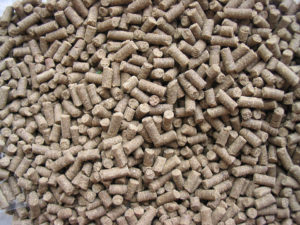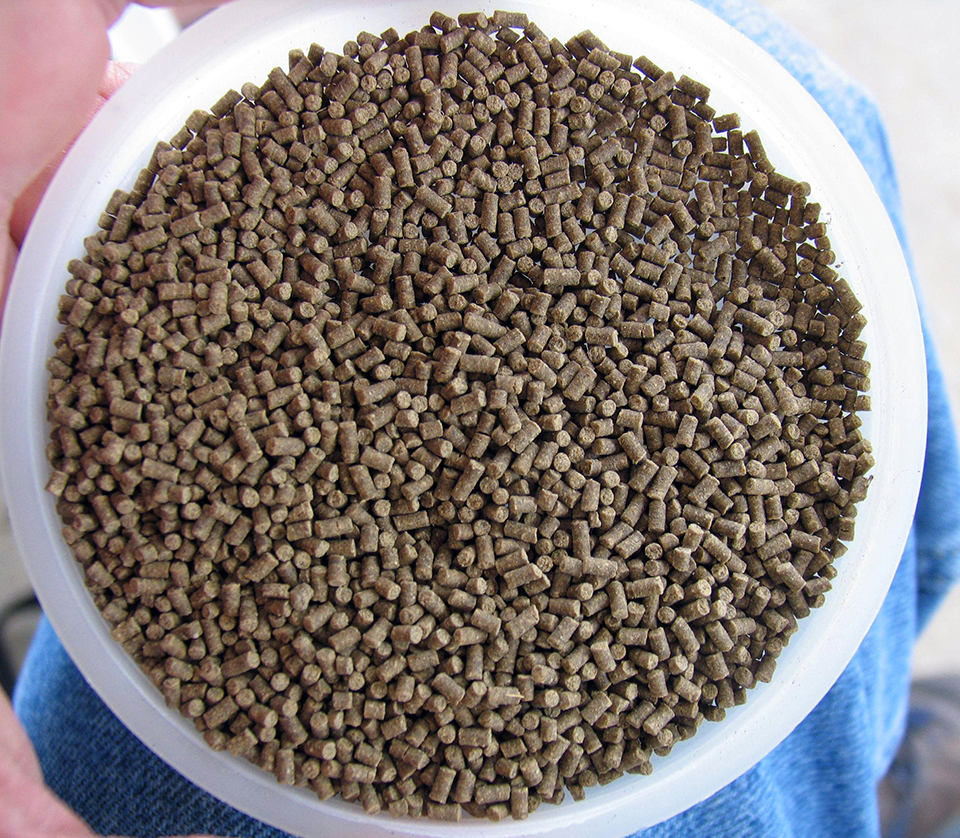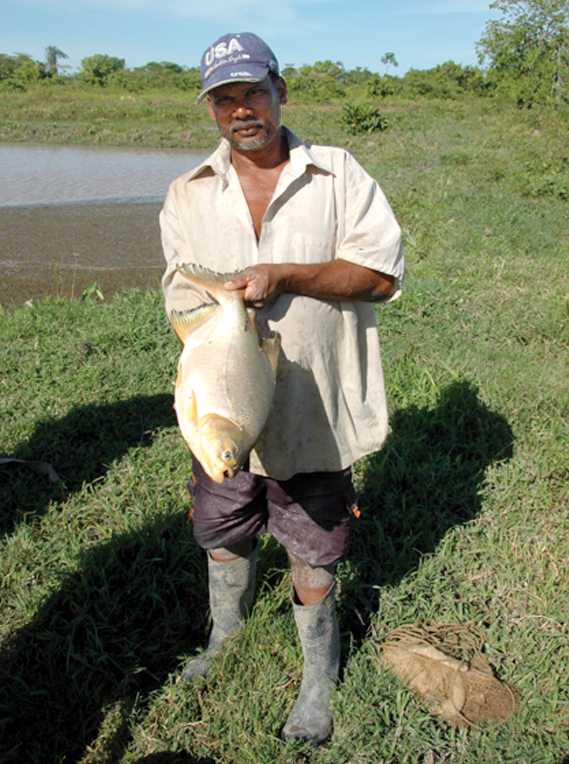How to introduce chemicals to aquatic animals is a concern

Optimized feed efficiency in aquaculture operations is accomplished by insuring the complete consumption of aquafeed that contains the minimal amount of nutrients required to maximize growth, and minimizing the time between feed application and ingestion to reduce feed input and concomitant nutrient waste. Maximum efficiency requires feeds that contain highly digestible nutrients and, increasingly, chemical stimulants.
Chemoreception
To survive in their natural environments, aquatic animals depend upon chemical stimuli for a variety of essential functions, including regulation of feeding behavior, migration, and synchronization of mating.
For chemoreception, finfish use either taste and smell “systems” or individual receptory cells. For example, olfaction systems and solitary cells are used for communication and homing. For the most part, receptor cells are located in olfactory pouches within the snouts of most fish and taste buds within the oral cavities of species like catfish. Bottom-dwelling fish have gustatory receptors on barbels, fins, and most of their body surfaces.
Chemoreception in crustaceans is typically oriented towards the anterior portion of the body but can also be associated with most appendages. As with finfish, this extensive distribution is related to such diverse uses as locating feed and mates, avoiding predators, and migration. Contact receptors in the flagellae of crustacean antennules are used for distance chemoreception, whereas those in mouth parts and appendages are used for food handling, gustation, and ingestion.

Characteristics of chemical stimulants
Most known chemical stimulants for finfish are nonvolatile and low in molecular weight. They contain nitrogen and can act as either acid or base. Water-soluble and heat-stable, compounds such as betaine, amino acids, nucleic acids, and quaternary ammonia compounds have broad biological distribution.
The efficacy of these compounds is determined primarily by their chemical compositions, how they interact, and their rates of diffusion into the water column. It follows, therefore, that once identified, these chemicals can be extracted from alternative, low-cost sources.
In finfish, some natural extracts are superior to chemically formulated ones. Of further interest is the finding that chemical-based feeding stimulation appears to be species-specific.
Effective stimulation
Chemicals added to aquatic feeds for the purpose of chemoattraction or feeding stimulation should insure fast location and rapid, complete ingestion. The issue of how to introduce the chemicals to aquatic animals is therefore of initial concern.
The most practical method of introduction is within feed. However, the effectiveness of this approach depends on the lability of the chemicals and overall feed stability. The extent to which leaching occurs is determined by feed particle size, shape, texture, buoyancy, and stability in water.
Chemical stimulants in aquaculture
A substantial amount of research has been undertaken to identify the potential benefits of chemical stimulants in aquaculture production environments. One benefit is increased initial palatability and consumption that could lead to an overall reduction in required feed input. This would occur due to complete consumption of the feed particles and improved transfer of nutrients by better identification of feed by the target animal.
Another benefit would be reduced levels of uneaten or wasted feed, resulting in improved feed conversion and water quality, which both potentially enhance growth rates. Increased feed performance and growth rates ultimately yield cost benefits, reduced nutrient losses and excretion of nitrogen, and more variation in feed formulas.
For finfish, chemical stimulants can reduce the time required for weaning fry from living prey to inert feeds. This results in increased production efficiency at hatcheries. Per-unit feed costs would also likely decrease due to reduced dietary levels of expensive feed ingredients.
Finfish research
Recent research on chemical stimulants and/or natural ingredients for applications in finfish aquaculture has included the use of freeze-dried krill for feed training largemouth bass, inosine-5-monophosphate as a feed enhancer, and krill hydrolysate as a feed attractant.
Studies have showed improved growth and performance in striped bass fed a plant-based diet, and evaluated feeding stimulants for young yellowtail snappers and juvenile gibel carp.
Shrimp research
Investigations into potential chemical stimulants for shrimp have primarily focused on the physiology of detection and improvement of palatability. In reality, relatively few studies have addressed chemoattraction and feeding stimulation in shrimp. Some bottlenecks to this research include achieving equal-choice opportunity, variable physical environments, the effects of dietary protein on attraction, and statistical issues.
Currently, the most common practical chemoattractants and feeding stimulants used in commercial shrimp production feeds are either whole organism meals (fishmeal, krill meal, crab meal, artemia meal, squid muscle or mantle meal) or extracts like fish oils and fish solubles. Normal rates of inclusion are highly variable because chemoattractants like fishmeal are also important nutrient sources used for other purposes.
The true value of chemical stimulants to penaeid shrimp farming will come by addressing the aforementioned bottlenecks through the development of practical, reproducible methods to evaluate the efficacy of chemoattractants and feeding stimulants. One such method of evaluation has been developed by researchers at the Texas Agricultural Experiment Station in Port Aransas, Texas, USA.
Attractant evolution
As more research into feed stimulants takes place, surprising new compounds, molecules, and substances, may emerge. Least-cost attractants may also be identified, with subsequent incorporation into formulated feeds without increases in per-unit feed cost.
Commercial attractants will probably grow to consist of a mixture of compounds because the location of, movement toward, and ingestion of feed involves more than one mode of action and multiple loci on animals. Chemoattractants are also required to be active for a maximum amount of time.
(Editor’s Note: This article was originally published in the October 2004 print edition of the Global Aquaculture Advocate.)
Now that you've reached the end of the article ...
… please consider supporting GSA’s mission to advance responsible seafood practices through education, advocacy and third-party assurances. The Advocate aims to document the evolution of responsible seafood practices and share the expansive knowledge of our vast network of contributors.
By becoming a Global Seafood Alliance member, you’re ensuring that all of the pre-competitive work we do through member benefits, resources and events can continue. Individual membership costs just $50 a year.
Not a GSA member? Join us.
Authors
-
Joe M. Fox, Ph.D.
Texas A&M University
6300 Ocean Drive
Corpus Christi, Texas 78412 USA -
Addison L. Lawrence, Ph.D.
Texas A&M University
6300 Ocean Drive
Corpus Christi, Texas 78412 USA -
Scott Walker
Texas A&M University
6300 Ocean Drive
Corpus Christi, Texas 78412 USA
Tagged With
Related Posts

Health & Welfare
10 paths to low productivity and profitability with tilapia in sub-Saharan Africa
Tilapia culture in sub-Saharan Africa suffers from low productivity and profitability. A comprehensive management approach is needed to address the root causes.

Health & Welfare
A case for better shrimp nutrition
Shrimp farm performance can often be below realistic production standards. Use proven nutrition, feeds and feeding techniques to improve profitability.

Health & Welfare
A holistic management approach to EMS
Early Mortality Syndrome has devastated farmed shrimp in Asia and Latin America. With better understanding of the pathogen and the development and improvement of novel strategies, shrimp farmers are now able to better manage the disease.

Health & Welfare
A look at aquaculture in Guyana
With its large quantities of water and little industry to pollute it, Guyana has the potential to become a greater player in global aquaculture.



